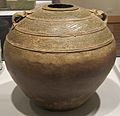Stoneware facts for kids

Stoneware is a type of pottery or other ceramic material. It is made by firing (baking) clay at very high temperatures. Stoneware is stronger and less porous than earthenware, which is fired at lower temperatures. It was invented after earthenware but before porcelain. Stoneware can be made from many different kinds of clay. It can be glazed (given a shiny coating) or left unglazed.
How Hot Does It Get?
Making pottery requires a lot of heat! In the past, reaching very high temperatures was a big challenge for potters. For a long time, people used lower temperatures to make pottery.
- Earthenware can be fired at temperatures as low as 600°C (1,112°F). This was done in simple pit firing. More often, earthenware was fired between 800°C (1,472°F) and 1,100°C (2,012°F).
- Stoneware needs much higher heat. It is usually fired in a special oven called a kiln at temperatures between 1,100°C (2,012°F) and 1,300°C (2,372°F).
- Porcelain, which is even harder, is fired at the highest temperatures, usually between 1,200°C (2,192°F) and 1,400°C (2,552°F).
These high temperatures make the clay very strong and durable.
Images for kids
-
Glazed Chinese stoneware storage jar from the Han Dynasty
-
A Chinese Yixing teapot, made during the Qing dynasty (around 1765–1835), decorated with painted slip.
-
A Wedgwood jasperware salt cellar featuring The Dancing Hours, made between 1780 and 1785.
See also
 In Spanish: Gres para niños
In Spanish: Gres para niños










